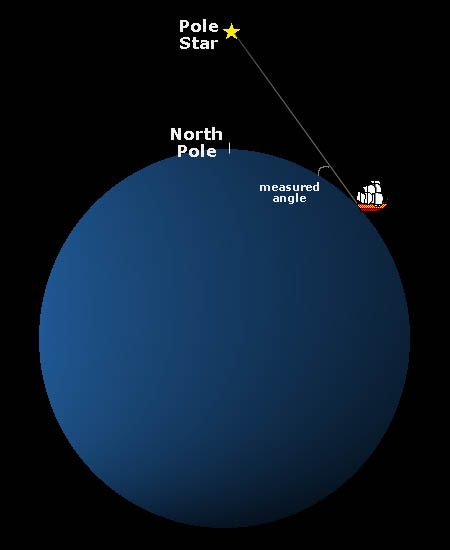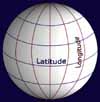This diagram shows how early navigators used the Pole Star to find how far north they were — how close to
the North Pole. They would measure the angle to the Pole Star. You can see that when the ship moves
northwards, the angle between the line to the Pole Star and the Earth's surface increases. Thus, the change
in the angle would tell the navigator the ship's position relative to the North Pole. Read on for more
explanations of navigation.
Navigation is the science of position-finding and charting a safe course. The two numbers, latitude and
longitude, used together, give the positio, in degrees, anywhere on Earth. Latitude tells how far north
or south of the equator a place is, and longitude tells how far it is east or west of the Greenwich meridian.
Because one degree equals about 60 nautical miles distance, the two numbers make a square 60 miles wide and 60
miles long (one nautical mile =1.15 land miles). For greater accuracy, each degree is divided up into to 60
minutes. A shorthand for sixty minutes is written 60'. This defines an area one mile by one mile at
the equator. For yet more precision each minute latitude or longitude is further divided into 60
seconds. One second is about 34 yards. A shorthand for sixty seconds is written 60". To navigate
successfully you need to find your position (degrees, minutes and preferable seconds) for both latitude and
longitude. Modern Global Position Satellite (GPS) systems are accurate to a few yards, a few seconds longitude
and latitude. But what did navigators do before then?
FINDING LATITUDE
At the surface, these lines of latitude are parallel to the equator. It's a simple matter to find out
which line of latitude (how far north or south) that you are on. To find you latitude you measure the angle
between the horizon and a reference point in the sky marking the pole beneath. An instrument called a sextant
is used to measure the angle accurately. In the Northern Hemisphere a bright star is almost directly above the
North Pole. This so-called "Pole Star" made navigation easier for early mariners. They simply sailed
along a line of latitude east or west to get most of the way to where they wanted and then finished
their journey by sailing directly north or south. It's harder in the Southern Hemisphere because there is
no convenient star. There you have to find a similar point in the sky above the South Pole but the idea
is the same.
FINDING LONGITUDE
It's much harder to find where you are east or west. Before the invention of Global Positioning Satellites
(GPS) and sophisticated navigation techniques, it was very hard to know on which line of longitude you were.
There are no convenient signposts in the sky. Like the sun, the stars seem to move. The usual method used by
mariners before reliable clocks were made was to throw a "Log Line" overboard to measure the ship&39;s
speed. If the speed was known navigators used "dead reckoning" to calculate their position (though the
calculation basically was a clever guess). Errors over long sea-voyages could soon amount to hundreds of
miles. Ships were wrecked on unknown coasts as a result of navigation errors. Because of these errors, in the
18th century England's Admiralty offered a huge reward for a reliable clock that could be used at sea. At
the equator, an error of one minute in the time on a clock (or chronometer as marine clocks were known) makes
an error of 60 nautical miles from the expected position.
To calculate longitude you need to know the angle of the sun and the time of day relative to a set location,
usually the Greenwich Meridian. An instrument called a sextant is used to measure the sun's angle. Again,
Navigation Tables are used. It is essential to know the exact time the observation is made. An error of one
minute in time will result in an error on the equator of 60 nautical miles.
The task to find the position on a line of longitude is made even more difficult of course, because of the
earth's daily rotation on its axis and the distance the ship has traveled. However, with an accurate clock
you can calculate out how far east or west of Greenwich (0º) you are.
Around 1000 AD early Viking voyagers could position themselves on a line of latitude using a simple sextant to
measure the angle between the horizon and Pole Star. This method was used by the Vikings to discover Greenland
and Newfoundland. About 750 years later John Harrison invented a clock accurate to half a minute over a year.
Navigators were now able to calculate longitude accurately. Before modern clocks, it was very difficult to
keep accurate time. John Harrison's precision clocks he called "chronometers", were able to
withstand a sea voyage. These were a technological breakthrough. That is why before the 18th century there
were so many shipwrecks — navigators could be hundreds of miles away from where they thought and sail the
ship right on to a reef. It also explains why maps before then were woefully inaccurate.
At last, navigators could find their exact position: they knew their latitude and they knew their longitude.
Where those lines crossed on their maps (known as 'charts' at sea) was their precise position on the
surface of the earth.
|

